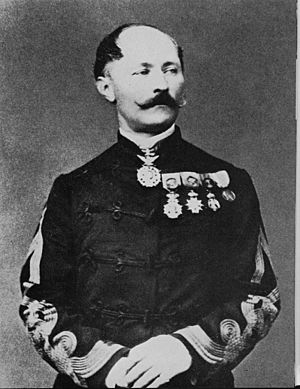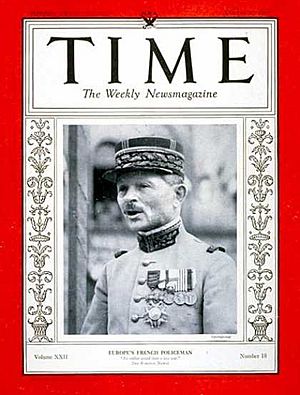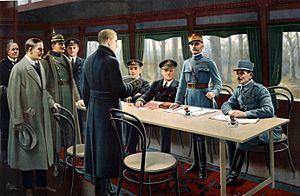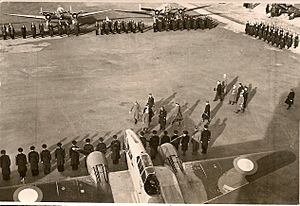Maxime Weygand facts for kids
Quick facts for kids
Maxime Weygand
|
|
|---|---|
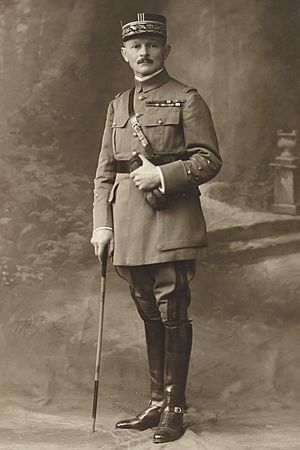
General Weygand c. 1940
|
|
| 30th Chief of the Army Staff | |
| In office 3 January 1930 – 10 February 1931 |
|
| Preceded by | Eugène Debeney |
| Succeeded by | Maurice Gamelin |
| Minister of National Defence | |
| In office 16 June 1940 – 11 July 1940 Serving with War Minister Louis Colson
|
|
| High Commissioner of the Levant | |
| In office 19 April 1923 – 29 November 1924 |
|
| Preceded by | Robert de Caix (acting) |
| Succeeded by | Maurice Sarrail |
| Personal details | |
| Born | 21 January 1867 Brussels, Belgium |
| Died | 28 January 1965 (aged 98) Paris, France |
| Nationality |
|
| Alma mater | École Spéciale Militaire |
| Military service | |
| Allegiance | |
| Branch/service | French Army |
| Years of service | 1887–1942 |
| Rank | Army general |
| Battles/wars | |
Maxime Weygand (born January 21, 1867 – died January 28, 1965) was a French military leader. He served in both World War I and World War II. During World War II, he was a high-ranking member of the Vichy regime. In this role, he carried out harsh policies against Jewish people during The Holocaust.
Weygand was born in Belgium but grew up in France. He studied at the Saint-Cyr military academy in Paris. After graduating in 1887, he became an instructor at the Cavalry School in Saumur. During World War I, Weygand worked as a staff officer for General Ferdinand Foch. Later, he advised Poland during the Polish–Soviet War. He also served as the High Commissioner of the Levant. In 1931, Weygand became the Chief of Staff of the French Army. He held this important position until he retired in 1935 at age 68.
In May 1940, Weygand was called back to duty. He took command of the French Army during the German invasion. After many military defeats, Weygand suggested that France should sign an armistice, which means stopping the fighting. France then surrendered. He joined Philippe Pétain's Vichy regime as Minister for Defence. He served until September 1940. Then, he was made Delegate-General in French North Africa. He was known for strictly applying German anti-Jewish policies in this role.
However, Weygand only wanted limited cooperation with Germany. Because of this, Adolf Hitler demanded his removal in November 1941. After the Allied invasion of North Africa in November 1942, the Germans arrested Weygand. He was held in Itter Castle in Austria until May 1945. When he returned to France, he was held for being a collaborator. But he was released in 1946 and cleared of charges in 1948. He passed away in Paris in January 1965 at the age of 98.
Contents
Early Life and Family
Maxime Weygand was born in Brussels, Belgium. His parents are unknown. For a long time, people thought he might be the son of Empress Carlota of Mexico and General Alfred Van der Smissen. Another idea was that he was the son of Leopold II, King of the Belgians, and his Polish mistress. Alfred Van der Smissen seemed a likely father because Weygand looked a lot like him. In 2003, a French journalist claimed to have found proof that Van der Smissen was indeed his father. The journalist said his mother was Mélanie Zichy-Metternich, who worked for Empress Carlota.
Weygand always said he did not know who his real parents were. As a baby, he was sent to Marseille, France. There, a widow named Virginie Saget raised him. He first thought she was his mother. At age six, he moved to the home of David Cohen de Léon. This financier was a friend of Leopold II. When Weygand became an adult, Francois-Joseph Weygand, an accountant for Mr. Cohen de Léon, legally recognized him as his son. This gave Maxime Weygand French citizenship.
Weygand wrote little about his early life in his memoirs. He mentioned that a governess and a chaplain at his college taught him strong Roman Catholic beliefs. His memoirs mostly begin when he entered the military school in Paris.
Military Career
Weygand entered the École Spéciale Militaire de Saint-Cyr as a foreign student from Belgium. He used the name "Maxime de Nimal." He graduated in 1887 and joined a cavalry regiment. After changing his name to Weygand and becoming a French citizen, he became an instructor at the Saumur military school.
Weygand became a captain but chose not to try for the difficult French staff college. He said he wanted to stay close to the soldiers. However, he later became an instructor at the Cavalry School. He also attended a special school for strategic instruction, even though he had not passed staff college.
In 1910, Weygand went with Joffre and Foch to observe the Imperial Russian Army exercises. He noted a lot of fancy events but also that the Russians did not want to share military details. As a lieutenant colonel, Weygand attended the last major French exercises before World War I in 1913. He said they showed "intolerable insufficiencies," like two divisions getting mixed up.
World War I Service
Early War Years
During World War I, Weygand worked as a staff officer. At the start of the war, he spent 26 days with the 5th Hussars. On August 28, he joined the staff of General Ferdinand Foch. He would serve under Foch for most of the war.
Weygand was promoted to brigadier general in 1916. He later wrote about the Anglo-French Somme Offensive in 1916. Foch commanded the French Army Group North during this battle. Weygand noted "constant mix-ups" with the British. He said they were learning how to run large operations. Their military ideas and methods were not yet the same as the French.
Supreme Allied Command Staff
Weygand was in charge of Foch's staff when Foch became Supreme Allied Commander in spring 1918. He was Foch's main assistant during the victories in late summer and until the war ended.
Weygand first led a small staff of 25–30 officers. Brigadier General Pierre Desticker was his second-in-command. Each department, like Operations or Intelligence, had its own head. From June 1918, Foch and Weygand took staff officers from the French Commander-in-Chief Philippe Pétain. This gave Foch more real power. By early July, British military and political leaders started to regret Foch's increased power. But Weygand later wrote that they had pushed for the change themselves.
Like Foch and most French leaders of his time, Weygand could not speak enough English to have a conversation. German was a more common second language for French officers. So, good interpreters were very important.
Weygand helped prepare for a meeting on July 24, 1918. At this meeting, Foch urged (successfully) to free the Marne area. This area had been taken by the Germans in May. This attack became the Second Battle of the Marne. Weygand personally delivered the orders for the Amiens attack to Haig.
In 1918, Weygand was part of the team that negotiated the armistice. The armistice was the agreement to stop fighting. It was Weygand who read out the armistice conditions to the Germans at Compiègne. This happened in a railway carriage. You can see him in photos of the armistice delegates. He is also standing behind Foch at Pétain's ceremony to become a Marshal of France in late 1918.
Service in Poland
During the Polish–Soviet War, Weygand was part of the Interallied Mission to Poland in July and August 1920. This mission supported the new Second Polish Republic against the Russian Soviet Federative Socialist Republic. The mission did not achieve much. Its report came out after the Polish Army had already won the important Battle of Warsaw. Still, the presence of the Allied missions led to a story that Allied forces saved Poland.
Weygand went to Warsaw expecting to lead the Polish army. But his hopes were quickly dashed. He had no good answer for Józef Piłsudski. During their first meeting on July 24, Piłsudski asked, "How many divisions do you bring?" Weygand had none to offer. From July 27, Weygand was an adviser to the Polish Chief of Staff, Tadeusz Jordan-Rozwadowski. This was a difficult job. Most Polish officers saw him as an outsider. They spoke only Polish, which he did not understand. He suggested plans that were rejected. One of his few lasting contributions was to insist on using written orders instead of spoken ones.
Norman Davies writes that Weygand was "quite out of his element." He was trained to give orders but was among people who did not want to obey. He favored defense, but the Poles wanted to attack. On August 18, Weygand became upset and threatened to leave. He was sad about his failure and Poland's disregard for the Allied powers. At the station in Warsaw on August 25, he received the Virtuti Militari, a high Polish military award. In Paris on August 28, crowds cheered him. He was kissed by the Premier and given the Grand Cross of the Legion of Honour. He did not understand what had happened. He admitted in his memoirs that he told a French journalist on August 21, 1920, that "the victory was Polish, the plan was Polish, the army was Polish." As Norman Davies notes, Weygand was the first person to be confused by a story that he was the hero of Warsaw. This story lasted for over forty years.
Return to France and the Middle East
After the mission to Poland, Weygand was without a job for a while. But in 1922, he became commander-in-chief in Levant. This was the French mandate in Lebanon and Syria. The next year, he was appointed High Commissioner of the Levant. He held this position for only one year.
Weygand returned to France in 1925. He became director of the Center for Higher Military Studies, a role he held for five years. In 1931, he was named Chief of Staff of the French Army. He also became vice president of the Supreme War Council and Inspector of the Army. He was also chosen as a member of the Académie française. He stayed in these roles until he retired in 1935 at age 68.
In August 1939, Prime Minister Édouard Daladier called Weygand back to active service. He was made commander-in-chief for the Orient Theatre of Operation.
World War II Service
By late May 1940, France was facing a military disaster after the German invasion. The Supreme Commander, Maurice Gamelin, was removed. Weygand was called back from Syria to replace him.
Weygand arrived on May 17. He immediately canceled a counter-attack that Gamelin had ordered. This attack was meant to cut off the German armored columns that had broken through the French front. Weygand lost two crucial days before finally using a similar plan. But by then, it was too late. The German Army infantry had caught up with their tanks and strengthened their positions.
Weygand then oversaw the creation of the Weygand Line. This was an early use of the Hedgehog tactic, where strong points are defended even if surrounded. However, the situation was very difficult. Most of the Allied forces were trapped in Belgium. Weygand complained that he had been called two weeks too late to stop the invasion.
On June 5, the second German offensive began. On June 8, Charles de Gaulle visited Weygand. De Gaulle had just been made Under-Secretary for War. According to de Gaulle's memoirs, Weygand believed it was "the end" for France. He laughed sadly when de Gaulle suggested fighting on. Weygand thought that after France was defeated, Britain would also soon seek peace. He hoped that after an armistice, the Germans would let him keep enough of a French Army to "maintain order" in France.
Fascist Italy entered the war and invaded France on June 10. That day, Weygand went to Prime Minister Paul Reynaud's office and demanded an armistice. Weygand was at a meeting on June 11. They discussed continuing the war from Brittany or French North Africa. At a Cabinet meeting on June 13, Marshal Pétain strongly supported Weygand's demand for an armistice. On June 14, Weygand told the British officer Alan Brooke that the French Army was falling apart and could not fight anymore. This led to the evacuation of the last British troops.
The French government moved to Bordeaux on June 14. At a Cabinet meeting on June 15, Reynaud suggested that the army should surrender so the fight could continue from abroad. Pétain agreed, but he was sent to talk to Weygand. In about fifteen minutes, Weygand convinced him that this would be a shameful surrender. The Cabinet then voted to ask the Germans about armistice terms.
After Reynaud resigned as Prime Minister on June 16, President Albert Lebrun appointed Pétain as prime minister. Weygand joined the new government as Minister for Defence. He was briefly able to stop Pierre Laval from becoming minister of foreign affairs.
Role in the Vichy Regime
The Vichy regime was set up in July 1940. Weygand continued to serve in Pétain's government as Minister for National Defence until September 1940. He was then appointed Delegate-General in French North Africa.
In North Africa, Weygand encouraged young officers not to join the French Resistance right away. He suggested they go along with the armistice for now, hoping to fight again later. He worked with Admiral Jean-Marie Charles Abrial to send opponents of Vichy to concentration camps in Southern Algeria and Morocco. Those imprisoned included supporters of de Gaulle, Freemasons, and Jews. He also arrested foreign volunteers and refugees. He strictly applied Vichy anti-Jewish legislation. With the help of the university chancellor, Georges Hardy, Weygand created a school quota for Jewish students. This forced most Jewish students, including young children, out of schools. Weygand did this on his own, without orders from Pétain.
Weygand gained a reputation for opposing full cooperation with Germany. He protested against the Paris Protocols of May 28, 1941. These agreements allowed the Axis powers to set up bases in French colonies. Weygand spoke out against Germany.
Weygand opposed German bases in French territory not to help the Allies. Instead, he wanted to protect the French Empire and keep its respect among the local people. Weygand seemed to favor only limited cooperation with Germany. His office provided military equipment to the German army in Africa. This included 1,200 French trucks and heavy artillery. However, Adolf Hitler demanded full cooperation. He pressured the Vichy government to remove Weygand in November 1941. A year later, in November 1942, after the Allied invasion of North Africa, the Germans arrested Weygand. He was held in Germany and then in the Itter Castle in Austria until May 1945. He was freed by United States Army troops after the Battle for Castle Itter.
Later Life
After returning to France, Weygand was held as a collaborator. He was kept at the Val-de-Grâce hospital. But he was released in May 1946 and cleared of charges in 1948. He died on January 28, 1965, in Paris, at the age of 98. He was married to Marie-Renée. They had two sons, Édouard and Jacques.
Beirut, a city in Lebanon, still has a major street named after him, Rue Weygand.
Awards and Honors
 France:
France:
- Légion d'honneur
- Knight (191?)
- Officer (1914)
- Commander (1918)
- Grand Officer (1920)
- Grand Cross (1924)
- Médaille militaire (1930)
- Croix de Guerre 1914–1918 with 3 palms
- Croix de Guerre 1939–1945 with 2 palms
- Croix de guerre des théâtres d'opérations extérieures with 1 palm
- Inter-Allied Victory Medal
- Commemorative Medal of the Great War
- Légion d'honneur
 Belgium:
Belgium:
- Commander of the Order of the Crown
- Croix de guerre
 United States: Distinguished Service Medal
United States: Distinguished Service Medal Morocco: Grand Cross of the Ouissam Alaouite Chérifien
Morocco: Grand Cross of the Ouissam Alaouite Chérifien United Kingdom:
United Kingdom:
 Sweden: Grand Cross of the Order of the Sword (1939)
Sweden: Grand Cross of the Order of the Sword (1939) Latvia: Order of Lāčplēsis, 2nd class.
Latvia: Order of Lāčplēsis, 2nd class. Kingdom of Yugoslavia: Order of the White Eagle
Kingdom of Yugoslavia: Order of the White Eagle
See Also
 In Spanish: Maxime Weygand for Kids
In Spanish: Maxime Weygand for Kids


